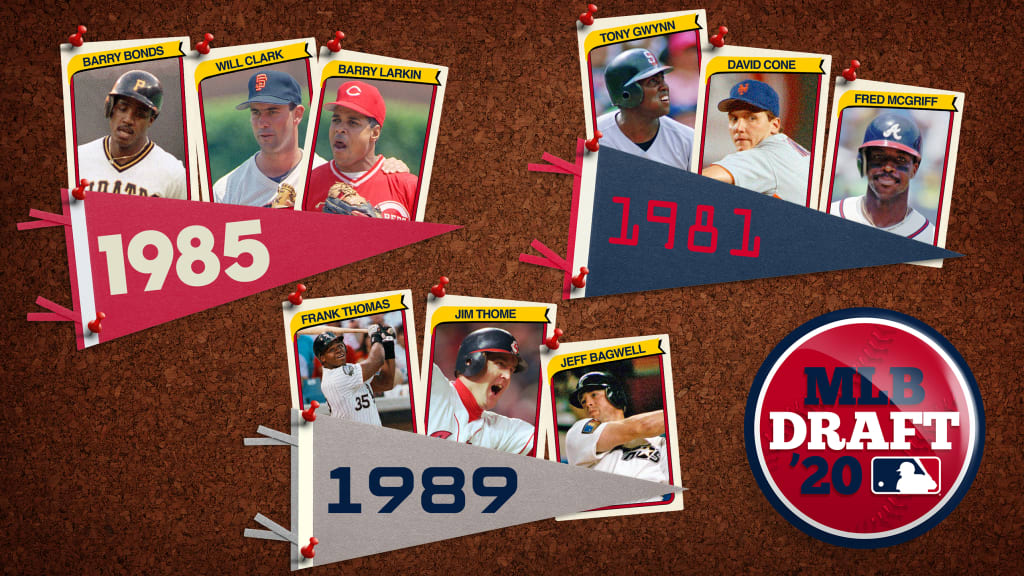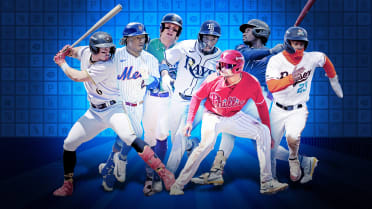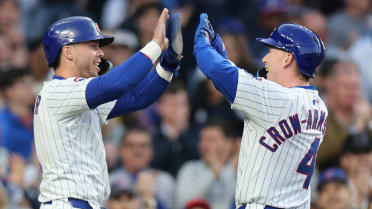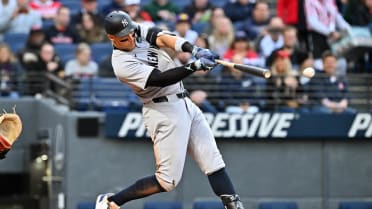
The 1985 MLB Draft represented a perfect storm of talent.
Five of the six best players selected in the 1982 Draft were high schoolers taken in the top 10 rounds: Barry Bonds (second round, Giants), Randy Johnson (fourth, Braves), Rafael Palmeiro (eighth, Mets), Barry Larkin (second, Reds) and Will Clark (fourth, Royals). It was a much different climate back then, with teams often looking at players who dared negotiate as being less than committed to playing pro ball.
Depending on who tells the story, San Francisco offered $60,000 and Bonds asked for $66,000, or it was $70,000 versus $75,000. In any case, the two sides refused to bridge a tiny gap and he went to Arizona State rather than turning pro.
Johnson, Palmeiro, Larkin and Clark also opted for college, as did fellow top-10-round picks B.J. Surhoff (fifth, Yankees), Walt Weiss (10th, Orioles), Bobby Witt (seventh, Reds), Joe Magrane (third, Pirates) and Pete Incaviglia (10th, Giants). By comparison, just two total players selected in the first 10 rounds of the 2019 Draft declined to turn pro.
The 1980s were the golden age of college baseball, as more schools began emphasizing the sport, attracting more quality athletes and offering a viable alternative to turning pro out of high school. College teams faced less NCAA restrictions than they do today, allowing them to offer more scholarships, play more games and provide more hands-on instruction.
An influx of talent at a time when colleges were developing players better than ever before resulted in a loaded Draft pool. Even before they got to select the players, evaluators were billing the Class of '85 as the best ever. They were correct, and 35 years later that still holds true.
The five best Draft years since the event began in 1965:
1) 1985
Surhoff, Clark, Witt and Larkin played together on the U.S. Olympic team and went in that order with the first four picks in June to the Brewers, Giants, Rangers and Reds, going on to play a combined 69 seasons in the Majors that included 19 All-Star selections and Hall of Fame enshrinement for Larkin. Bonds went sixth to the Pirates and became baseball's home run king while accumulating more Wins Above Replacement (162.8) than any player in Draft history. Incaviglia (No. 8, Rangers), Weiss (No. 11, Athletics), Magrane (No. 18, Cardinals) and Palmeiro (No. 22, Cubs) also resurfaced in the first round and had lengthy big league careers, as did high schoolers Brian McRae (No. 17, Royals) and Gregg Jefferies (No. 20, Mets).
That's the best first round in Draft history, and there's plenty more talent behind it. Johnson, who had yet to harness his fearsome stuff, lasted until the Expos stole him in the second round with the 36th overall choice. He and John Smoltz, a high schooler who dropped to the Tigers in the 22nd round because of signability concerns, have joined Larkin in Cooperstown.
Other later-round standouts include Mark Grace (24th round, Cubs), Brady Anderson (10th, Red Sox), Randy Velarde (19th, White Sox) and Mike Stanley (16th, Rangers). The secondary phase of the January Draft spawned Chuck Finley (No. 4 overall, Angels) and John Wetteland (second, Dodgers), while Todd Stottlemyre (No. 3 overall, Blue Jays) came out of the secondary phase in June.
2) 1981
The Draft took on a heavy college flavor in 1981, comprising the majority of the first-round picks (17 of 26) for the first time. Interestingly, none of the year's 10 top players came from the first round and half of them were high schoolers.
San Diego general manager Jack McKeon found the biggest prize when he watched his son Kasey play at San Diego State and spotted Hall of Famer Tony Gwynn. The Padres took Gwynn in the third round on the same day that the San Diego Clippers selected the all-Western Athletic Conference guard in the 10th round of the Draft.
After Gwynn, the best 1981 draftees were David Cone (Royals, third round), Fred McGriff (Yankees, ninth), Mark Langston (Mariners, second), Devon White (Angels, sixth), Frank Viola (Twins, second), Lenny Dykstra (Mets, 13th), Paul O'Neill (Reds, fourth), Mark Gubicza (Royals, second) and Sid Fernandez (Dodgers, third). Nineteen of the first-rounders reached the Majors, including Kevin McReynolds (Padres, No. 6 overall), Mike Moore (Mariners, No. 1), Joe Carter (Cubs , No. 2) and Ron Darling (Rangers, No. 9). Darling was the favorite to go No. 1 until he spooked Seattle by hiring an agent.
3) 1989
The 1989 Draft matched 1976 and 1977 with a record four Hall of Famers, only one of whom was a first-rounder -- and a lot of teams thought the White Sox reached for a one-dimensional player when they chose Frank Thomas seventh overall. Jeff Bagwell (Red Sox, fourth round) and Jim Thome (Indians, 13th) were small-school players and considered defensive liabilities, while Trevor Hoffman (Reds, 11th) was a shortstop who had yet to convert to the mound.
Besides Hoffman, the year's top performers all were position players: Bagwell, Thomas, Thome, John Olerud (Blue Jays, third round), Jeff Kent (Blue Jays, 20th), Brian Giles (Indians, 17th), Chuck Knoblauch (Twins, No. 25 overall), Tim Salmon (Angels, third), Mo Vaughn (Red Sox, No. 23) and Ryan Klesko (Braves, fifth). Scott Erickson (Twins, fourth), Denny Neagle (Twins, third) and Ben McDonald (Orioles, No. 1) were the best of the rest of the pitchers.
McDonald, the top choice, and Olerud, the likely No. 2 pick before a brain aneurysm curtailed his junior season at Washington State, ushered in an era of skyrocketing bonuses. They both shattered the previous bonus record and landed the second- and third-largest big league contracts in Draft history, a $375,000 bonus as part of an $824,000 guarantee for McDonald and a $575,000 bonus and a $800,000 deal for Olerud. Both played a minor role in the American League East race that September.
4) 1986
Following the best Draft ever, 1986 stands out more for its depth than its top-end talent. It has yet to produce a Hall of Famer, but it has generated more players who have accumulated at least 5 WAR (49) and 10 WAR (31) than any other year. And its three best players -- Curt Schilling (Red Sox, second round in January), Kevin Brown (Rangers, No. 4 overall) and Gary Sheffield (Brewers, No. 6) -- could wind up in Cooperstown one day.
Besides Schilling, two of 1986's top picks came from outside the main June event in Moises Alou (Pirates, No. 2 overall, January regular) and Greg Vaughn (Brewers, No. 4 overall, June secondary). MLB switched to a single Draft in June the following year.
In the June regular phase, each of the first six choices had long careers: Jeff King (Pirates, No. 1), Greg Swindell (Indians, No. 2), Matt Williams (Giants, No. 3), Brown, Kent Mercker (Braves, No. 5) and Sheffield. Later-round success stories included Tom Gordon (Royals, sixth round), Pat Hentgen (Blue Jays, fifth), Kevin Tapani (Athletics, second), Chris Hoiles (Tigers, 19th), Erik Hanson (Mariners, second), Rick Reed (Pirates, 26th), Rey Sanchez (Rangers, 13th) and Todd Zeile (Cardinals, second).
5) 2002
The 2002 Draft is best known for "Moneyball," the best-selling book and Academy Award-nominated film that focused in large part on the Athletics' scouting efforts. Oakland had seven picks before the first round and a supposedly revolutionary approach, yet had little success after spending its first two choices on Nick Swisher (No. 16 overall) and Joe Blanton (No. 24). And while author Michael Lewis touted the superiority of college players, just one of the year's 13 top performers hailed form a four-year school (Curtis Granderson, Tigers, third round).
Misconceptions aside, 2002 was a strong Draft nevertheless and its top performers -- Zack Greinke (Royals, No. 6 overall), Joey Votto (Reds, second), Cole Hamels (Phillies, No. 17) and Jon Lester (Red Sox, second) are still chugging along. Other draftees of note include Russell Martin (Dodgers, 17th), Howie Kendrick (Angels, 10th), Brian McCann (Braves, second), Matt Cain (Giants No. 25), Denard Span (Twins, No. 20), Josh Johnson (Marlins, fourth), Prince Fielder (Brewers, No. 7) and Scott Kazmir (Mets, No. 15).
The very top of the Draft was filled with disappointment, however. Bryan Bullington (Pirates, No. 1) won exactly one big league game, Adam Loewen (Orioles, No. 4) won only 10 and Chris Gruler (Reds, No. 3) and Clint Everts (Expos, No. 5) never got there because of injury issues. B.J. Upton (Rays, No. 2) arrived in Tampa Bay at age 19 and spent 12 years in the Majors but peaked with a 20-20 season at age 22.
The challengers
More recent Draft years haven't had as much time to build their résumés, but both 2009 and 2011 look like they could crack the top five and perhaps pose a challenge to 1985 by the time they're done.
The incomparable Mike Trout (Angels, No. 25 overall) leads the 2009 contingent, which also features Paul Goldschmidt (D-backs, eighth round), Nolan Arenado (Rockies, second), Stephen Strasburg (Nationals, No. 1), Kyle Seager (Mariners, third), Matt Carpenter (Cardinals, 13th) and J.D. Martinez (Astros, 20th).
At the time, 2011 was hailed as a potentially exceptional class and has lived up to its billing. Mookie Betts (Red Sox, fifth round) is the standard bearer, but most of the best players went early: Anthony Rendon (Nationals, No. 6 overall), Francisco Lindor (Indians, No. 8), George Springer (Astros, No. 11), Gerrit Cole (Pirates, No. 1), Trevor Story (Rockies, supplemental first), Sonny Gray (Athletics, No. 18), Javier Baez (Cubs, No. 9), Jackie Bradley Jr. (Red Sox, supplemental first), Kolten Wong (Cardinals, No. 22), Trevor Bauer (D-backs, No. 3) and the late Jose Fernandez (Marlins, No. 14). Marcus Semien (White Sox, sixth) and Kyle Hendricks (Rangers, eighth) are two college overachievers.
Jim Callis is a reporter for MLB.com. Follow him @jimcallisMLB and @jimcallis.bsky.social. Listen to him on the weekly MLB Pipeline Podcast.




